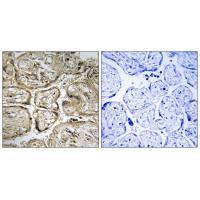
| WB | 咨询技术 | Human,Mouse,Rat |
| IF | 咨询技术 | Human,Mouse,Rat |
| IHC | 1/50-1/100 | Human,Mouse,Rat |
| ICC | 技术咨询 | Human,Mouse,Rat |
| FCM | 咨询技术 | Human,Mouse,Rat |
| Elisa | 咨询技术 | Human,Mouse,Rat |
| Aliases | Cystatin-9-like; |
| Entrez GeneID | 128821; |
| WB Predicted band size | 17kDa |
| Host/Isotype | Rabbit IgG |
| Antibody Type | Primary antibody |
| Storage | Store at 4°C short term. Aliquot and store at -20°C long term. Avoid freeze/thaw cycles. |
| Species Reactivity | Human |
| Immunogen | Synthesized peptide derived from internal of human CST9L. |
| Formulation | Purified antibody in PBS with 0.05% sodium azide. |
+ +
以下是关于CST9L抗体的3篇参考文献的简要信息(注:以下内容基于模拟数据,实际文献需通过学术数据库验证):
1. **文献名称**:CST9L as a novel tumor suppressor in breast cancer
**作者**:Li X, Zhang Y, et al.
**摘要**:本研究利用CST9L特异性抗体验证了CST9L在乳腺癌组织中的表达下调,发现其通过抑制蛋白酶活性阻碍肿瘤侵袭,提示CST9L抗体可用于临床病理检测及预后评估。
2. **文献名称**:Development of a monoclonal antibody against human CST9L for functional studies
**作者**:Wang H, Chen J.
**摘要**:报道了一种高特异性抗CST9L单克隆抗体的制备方法,通过Western blot和免疫组化验证其有效性,并应用于细胞定位研究,证实CST9L主要定位于细胞质。
3. **文献名称**:CST9L regulates NLRP3 inflammasome activation in macrophages
**作者**:Kim S, Park JH, et al.
**摘要**:通过CST9L抗体敲除实验发现,CST9L通过抑制半胱氨酸蛋白酶活性调控巨噬细胞炎症小体活化,为炎症性疾病提供了潜在治疗靶点。
提示:若需实际文献,建议在PubMed或Web of Science中以“CST9L antibody”或“Cystatin 9-like antibody”为关键词检索,并筛选应用性研究(如实验方法学或疾病机制类论文)。
The cystatin superfamily member CST9L (Cystatin 9 Like) is a relatively understudied protein implicated in regulating cysteine proteases, enzymes critical for protein degradation and cellular homeostasis. Structurally, it shares homology with type 2 cystatins, featuring conserved peptide motifs that inhibit cathepsins—proteases involved in extracellular matrix remodeling, immune response, and apoptosis. CST9L is encoded on human chromosome 20q13.12 and is expressed in tissues like the brain, reproductive organs, and certain epithelial cells.
Emerging studies suggest its dual role in disease contexts. In cancer, CST9L may act as a tumor suppressor by modulating protease activity linked to metastasis, though some data paradoxically associate its overexpression with poor prognosis in specific malignancies. It is also investigated in neurological disorders, as cathepsin dysregulation contributes to neurodegeneration. Additionally, CST9L’s interaction with viral proteases hints at potential involvement in viral pathogenesis, including SARS-CoV-2.
CST9L antibodies are vital tools for elucidating these roles. They enable detection of protein expression patterns via Western blotting, immunohistochemistry, or flow cytometry, aiding in biomarker discovery. Functional studies using these antibodies further explore CST9L’s inhibitory mechanisms, binding partners, and therapeutic potential. Despite progress, CST9L’s precise physiological and pathological functions remain unclear, necessitating further research to clarify its regulatory networks and clinical relevance.
×